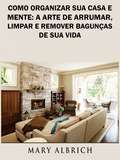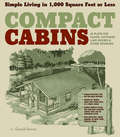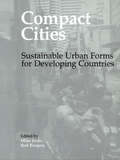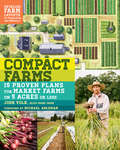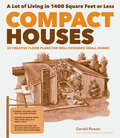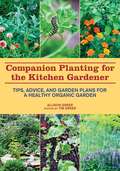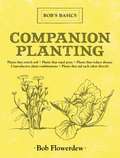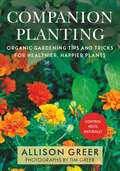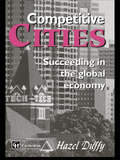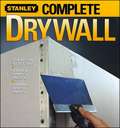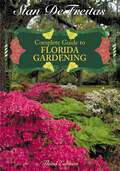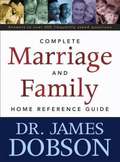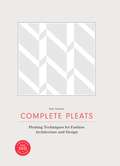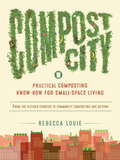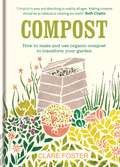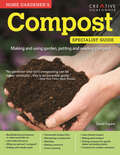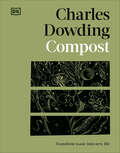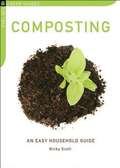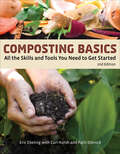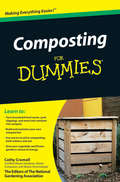- Table View
- List View
Como Organizar Sua Casa e Mente: A Arte de Arrumar, Limpar e Remover Bagunças de Sua Vida
by Beatriz dos Santos Maranho Mary AlbrichVoce sente como se seus esforcos para manter sua casa ou espacos pessoais organizados sao ineficazes? Mary eleva os parametros de limpeza e organizacao com sue novo livro. Este guia detalhado é um método rápido, fácil e eficiente para limpar sua casa ou espaços pessoais. Esses passos permitirão que você remova a desordem interminável da sua vida, limpe sua mente e torne-se mais eficiente, sentindo-se menos estressado e mais feliz!
Compact Cabins: Simple Living in 1000 Square Feet or Less; 62 Plans for Camps, Cottages, Lake Houses, and Other Getaways
by Gerald RowanIn the woods, on a mountaintop, or at the water&’s edge, a small cabin can fulfill big dreams. With attention to efficient living and minimizing energy footprints, Gerald Rowan provides 62 designs for compact and creative buildings that are flexible enough to fit whatever your needs may be. Rowan includes detailed floor plans with plenty of modular elements that make the designs adaptable and easy to recreate with cost-effective, low-maintenance materials. Make the most of the cabin you call home, regardless of its size.
Compact Cities: Sustainable Urban Forms for Developing Countries
by Mike Jenks Rod BurgessThis collection of edited papers forms part of the Compact City Series, creating a companion volume to The Compact City (1996) and Achieving Sustainable Urban Form (2000) and extends the debate to developing countries. This book examines and evaluates the merits and defects of compact city approaches in the context of developing countries in Africa, Asia and Latin America. Issues of theory, policy and practice relating to sustainability of urban form are examined by a wide range of international academics and practitioners.
Compact Farms: 15 Proven Plans for Market Farms on 5 Acres or Less; Includes Detailed Farm Layouts for Productivity and Efficiency
by Josh VolkSmall is beautiful, and these 15 real farm plans show that small-scale farmers can have big-time success. Compact Farms is an illustrated guide for anyone dreaming of starting, expanding, or perfecting a profitable farming enterprise on five acres or less. The farm plans explain how to harness an area&’s water supply, orientation, and geography in order to maximize efficiency and productivity while minimizing effort. Profiles of well-known farmers such as Eliot Coleman and Jean-Martin Fortier show that farming on a small scale in any region, in both urban and rural settings, can provide enough income to turn the endeavor from hobby to career. These real-life plans and down-and-dirty advice will equip you with everything you need to actually realize your farm dreams.
Compact Houses: 50 Creative Floor Plans for Well-Designed Small Homes
by Gerald RowanDiscover the huge possibilities of a small house! Whether you’re building from scratch or retrofitting an existing structure, these 50 innovative floor plans will show you how to make the most of houses measuring 1,400 square feet or less. Gerald Rowan presents creative and efficient layouts that use every inch of space, with tips on fully maximizing closets, porches, bathrooms, attics, and basements. From reorganizing a small storage area to building a brand-new home, you’ll find a detailed design to fit your family’s needs.
Companion Planting for Beginners: Pair Your Plants for a Bountiful, Chemical-Free Vegetable Garden
by Brian LowellIf you want a vibrant, chemical-free vegetable garden, companion planting is the solution.Did you know tomatoes produce a natural insecticide that can help protect carrots against pests? Or that planting mint near lettuce can repel slugs? Every gardener knows that the key to an abundant harvest in their vegetable garden is controlling pests and disease, while still maintaining a healthy growing environment. But it is possible to have a healthy, thriving vegetable garden without using dangerous chemicals? It is, as long as you know how to pair up the right plants. Organic gardeners have known for years that planting the right plants together is the key to minimizing pests, improving soil quality, and increasing the yield of their gardens, and almost any vegetable you can grow likely has a beneficial companion. Companion planting is the ideal way to avoid using chemicals, while still increasing the efficiency of your garden. Expert organic gardener Brian Lowell will teach you how to use plants to create a beautiful, vibrant vegetable garden that will be free of toxic chemicals. Here's what you'll find inside:Handy companion planting pairings for all of the most common garden vegetablesPractical, simple photography and colorful illustrations for dozens of beneficial planting configurations Expert advice from a master gardener that is specifically designed for beginnersLoads of troubleshooting tips for fixing common issues with companion-planted gardensTips for setting up the perfect vegetable garden, including practical advice on watering, soil management, troubleshooting, and more
Companion Planting for the Kitchen Gardener: Tips, Advice, and Garden Plans for a Healthy Organic Garden
by Allison GreerCompanion planting techniques have been used for centuries to facilitate better, more nutritious, and more abundant crops. Did you know that beets will grow better if surrounded by mint or garlic, but tomatoes should not be planted near cabbage? Flax helps protect some root vegetables from pests, and tomatoes will thrive when planted near carrots (though the carrots may wind up stunted). Your celery will be happier if it's far away from corn, but broccoli and dill make a terrific garden pair. It's a lot to think about, but there's no reason to feel overwhelmed. With Companion Planting for the Kitchen Gardener, you'll have all the information you need in clear, concise terms and with charts and garden plans you can copy or modify to suit your family's needs.Starting with the basics of organic gardening, such as how to prepare quality soil and the importance of cover crops and organic fertilizer, authors Allison and Tim Greer explain the principles of companion planting, how plants interact, and how you can use that information to your garden's benefit. There is an entire chapter devoted to each of the fifteen most popular vegetables, with charts, diagrams, and descriptions of each-a treasure for gardeners with busy lives who want an easy reference guide for planning their ideal kitchen garden. Full of gorgeous, full-color photographs and easy-to-follow diagrams, this is a beautiful, useful guide for the home organic gardener.
Companion Planting: Bob's Basics (Bob's Basics)
by Bob FlowerdewAccording to Flowerdew, the key to successful organic gardening is working with nature, rather than against it, to get your plants to thrive. This practice is called companion planting, and it is explained in this volume with a style that is both no-nonsense and reader-friendly. Topics range from plants that compete for nutrients to plants that enrich their soil for future crops. Gardeners of all levels will learn from Companion Planting and their gardens will benefit from happy and healthy plants.
Companion Planting: Organic Tips and Tricks for Healthier, Happier Plants
by Allison GreerA Practical and Beautiful Guide to Companion Planting for Organic Gardening SuccessCompanion planting techniques have been used for centuries to facilitate better, more nutritious, and more abundant crops. With Companion Planting, you’ll have all the information you need in clear, concise terms and with charts and garden plans you can copy or modify to suit your family’s needs.Starting with the basics of organic gardening, such as how to prepare quality soil and the importance of cover crops and organic fertilizer, author Allison Greer explains the principles of companion planting, how plants interact, and how you can use that information to your garden’s benefit. Fun companion planting facts include:Beets will grow better if surrounded by mint or garlicTomatoes should not be planted near cabbageFlax helps protect some root vegetables from pestsTomatoes will thrive when planted near carrotsYour celery will be happier if it’s far away from cornBroccoli and dill make a terrific garden pairAnd much, much more!Companion Planting is a treasure for gardeners with busy lives who want an easy reference guide for planning their ideal kitchen garden.
Competitive Cities: Succeeding in the Global Economy
by Hazel DuffyCompetitive Citites is an assessment of the way in which `partnership', a word much used by politicians, has helped to shape the economic futures of four cities on both sides of the Atlantic - Atlanta, Toronto, Birmingham and Rotterdam.
Complete Do-it-Yourself Manual Newly Updated
by Editors Of Family HandymanThe leading manual for home improvements is getting an update to address current codes, latest materials, tools and technology.The bestselling, most comprehensive guide to home improvements has been revised and updated once again since it's revision in 2005. Over 10 million copies of READER'S DIGEST COMPLETE DO-IT-YOURSELF MANUAL have been sold since it's original publication in 1973. In 2005, the manual got bigger and better than ever, when The Family Handyman and Reader's Digest joined forces and completely revised, updated, rewrote, and redesigned this home improvement classic. Now in 2014, The Family Handyman has once again updated and revised this do-it-yourself classic to make it relevant to today's homeowners and DIYers.. Written in a style of text that addresses readers in a very accessible, conversational tone for easy, user-friendly assistance with every do-it-yourself task. All instructions and materials have been updated to address current codes (electrical, plumbing and building), and revised to indicate the very latest in materials, tools, and technology. Suitable for beginners and experts alike, this newly revised edition includes: * Over 3,000 photos and illustrations to make complex projects and repairs easy to understand * Twice as many storage projects that help home owners cut clutter * New building materials that yield great-looking, long-lasting results--and low maintenance! * New technology that lets homeowners save energy, add convenience or improve security. * New building codes that make homes safer, more energy-efficient and trouble-free. The book's tried-and-true instructions provide do-it-yourself solutions to a ton of problems that could cost a fortune if you had to hire a professional. This manual is a "must-have" reference guide for every home-owning man or woman.
Complete Drywall
by Ken SideyComplete step-by-step instruction to build or repair walls and ceilings; Basic techniques to plan, select, cut, hang, tape, and sand drywall; Addresses drywall remodeling issues, and unusual situations; Professional drywall techniques for corners, curved walls, arched ceilings, and specialty finishes; Advice to help select tools and materials, including specialty drywall tools; Pre-start checklists, professional tips, and photographs give homeowners confidence to tackle advanced projects; Advanced projects, such as decorative construction and finishes.
Complete Guide to Florida Gardening
by Stan DeFreitasMore comprehensive than ever, the Complete Guide to Florida Gardening explains in step-by-step fashion how to create one's own personal outdoor paradise. Addressing the needs of gardening notvices, seasoned hobbyists, and horitculture professionals alike, Stan DeFreitas has, once again, created a reference book that no Florida gardener should be without.
Complete Marriage and Family Homes Reference Guide
by Dr James DobsonThe Complete Marriage and Family Home Reference Guide by Dr. James Dobson, America's most respected expert on marriage, parenting, and the family. This comprehensive, easy-to-access resource offers time-tested, biblical based information to help build healthy, God-honoring families.
Complete Pleats: Pleating Techniques for Fashion, Architecture, Design
by Paul JacksonPaul Jackson‘s major new title Complete Pleats is the most comprehensive book about pleating on the market.It explains how pleating systems can be stretched, compressed, flared, skewed, multiplied, and mirrored, showing how from simple ideas, a huge number of original pleat forms can be created. Each technique is explained with a series of step-by-step photographs and line illustrations, enabling the designer to work through the basic principles of pleating and then adapt them to their specific needs. Complete Pleats also features more than 60 examples of pleats from the worlds of architecture, fashion, and product design.Paul Jackson has taught pleating techniques to students of Fashion Design for 30 years, in both paper and fabric. Complete Pleats is the definitive practical guide for anyone wishing to create and make pleats. The book includes a DVD featuring 23 videos of pleating techniques.
Complete Pleats: Pleating Techniques for Fashion, Architecture, Design
by Paul JacksonPaul Jackson‘s major new title Complete Pleats is the most comprehensive book about pleating on the market.It explains how pleating systems can be stretched, compressed, flared, skewed, multiplied, and mirrored, showing how from simple ideas, a huge number of original pleat forms can be created. Each technique is explained with a series of step-by-step photographs and line illustrations, enabling the designer to work through the basic principles of pleating and then adapt them to their specific needs. Complete Pleats also features more than 60 examples of pleats from the worlds of architecture, fashion, and product design.Paul Jackson has taught pleating techniques to students of Fashion Design for 30 years, in both paper and fabric. Complete Pleats is the definitive practical guide for anyone wishing to create and make pleats. The book includes a DVD featuring 23 videos of pleating techniques.
Complex Housing: Designing for Density
by Julia Williams RobinsonComplex Housing introduces an architectural type called complex housing, common to the Netherlands and found in other Northern European countries. Eight fully illustrated case studies show successful approaches to designing for density, which reflect values such as long-term planning, a right to housing, and access to light and air. The case studies demonstrate a wide range of applications including a mixture of urban and suburban sites, various numbers of dwelling units, low- to high-density approaches, different architectural styles, and organizational strategies that can be adopted in projects elsewhere. More than 350 color images.
Compost City: Practical Composting Know-How for Small-Space Living
by Rebecca LouieThese days, everyone's talking about compost.Along with backyard chickeners, balcony beekeepers, rooftop farmers, and community gardeners, urban composters are part of a bumper crop of pioneers who are redefining the green space of crowded towns and cities.You may think you need a big yard to compost. Think again. Compost City teaches you how to easily choose and care for a compost system that fits perfectly into your (tiny) space, (busy) schedule, and (multifaceted) lifestyle.Whether you live in a cramped apartment or a sprawling town house, or you dream of composting in a shared space with a group of friends or colleagues, Compost City provides simple and effective indoor and outdoor composting options.Packed with research, expert testimonies, and a healthy dose of humor, Compost City will help you: * compost your food scraps and yard waste with ease * ease your fears of backbreaking labor, obnoxious odors, big messes, and creepy crawlies (hint: you can compost successfully without any of the above!) * convince compost-wary family, friends, neighbors, and community leaders to green-light your compost dreamsCompost City serves all eco-curious citizens from casual hobbyists to staunch activists.Put your compost cap on. Whether you compost one tea bag or whole honking barrelfuls of scraps at a time, you're about to have a whole lot of fun.
Compost: How To Make And Use Organic Compost To Transform Your Garden
by Clare FosterIn this new edition of her hands-on guide to the art of composting, House & Garden garden editor, Clare Foster, shows you how to build a compost box, select the best ingredients and put the resulting organic compost to the best use in your outdoor space. By taking some dead leaves, grass cuttings and old banana skins and enlisting the help of bacteria, insects and nature, you can improve and enrich your soil, feed your plants and nourish your vegetables, restoring the natural balance of life in your garden.
Compost: How to make and use organic compost to transform your garden
by Clare FosterIn this new edition of her hands-on guide to the art of composting, House & Garden garden editor, Clare Foster, shows you how to build a compost box, select the best ingredients and put the resulting organic compost to the best use in your outdoor space.By taking some dead leaves, grass cuttings and old banana skins and enlisting the help of bacteria, insects and nature, you can improve and enrich your soil, feed your plants and nourish your vegetables, restoring the natural balance of life in your garden.
Compost: Making and using garden, potting, and seeding compost (Home Gardener's)
by David SquireA complete reference to making and using compost to reduce environmental impact and garden sustainably for beginning, veteran and organic gardeners. In recent times, people have become much more ecologically aware and also more keen to minimize their carbon footprint. This, coupled with the pressure from governments to recycle household waste, means that creating and using garden compost is becoming almost essential knowledge. This guide gives gardeners all the information they need about starting to make their own compost, storing it and using it. Information on different types of compost -- what they consist of, what they are good for and how they are best stored -- is given, before moving on to explore in detail how to create your own compost. Guidance is also given for those who wish to construct their own compost bin. There are specific chapters explaining wormeries and green manuring, as well as a wealth of information on seed and potting composts.
Compost: Transform Waste into New Life
by Charles DowdingLearn how to make compost gold from the master of healthy soil.Charles Dowding puts feeding the soil at the heart of his No Dig method of growing. He explains how to use your kitchen and garden waste to make homemade compost so that your plants can truly flourish.Discover what you can compost, how to get the perfect balance, and different ways to compost whatever your space with this beautiful, infallible guide.
Composting
by Nicky ScottA full-color guide for both beginners and experienced composters, with an A-Z reference section. Composting is fun, easy and very satisfying! You can make compost even if you live in an apartment or don't have access to a garden. There are lots of good reasons to make compost: bull; A third to two-thirds of the average garbage can contents can be composted, so you can lighten your bin-and stop it smelling. bull; Less organic material is sent to landfill, so less noxious liquids and greenhouse gases-especially methane-are produced. bull; Composting saves you money-you won't need to buy any more peat-based compost! This book will give you all the information you need for successful composting.
Composting Basics: All the Skills and Tools You Need to Get Started (How To Basics)
by Eric Ebeling Carl Hursch Patti OlenickFrom bin placement to vermicomposting, learn how to naturally recycle household waste—whether you live in the country, the suburbs, or the city. You don&’t need a science degree or a shed full of sophisticated equipment to make quality compost. What you need to get started is the know-how provided in this basic how-to book along a little elbow grease and the pile of organic materials you regularly throw away. Nature does the rest. Whether you live in a rural or urban home, whether you have a garden or not, you can recycle household waste in an environmentally friendly way and turn it into black gold: compost. You&’ll learn what and how to compost, how to make or buy bins, how to build a compost pile and make compost tea, and how to compost with worms. It&’s simple and easy to do, and the best part is that you&’ll be saving money and helping to save the earth as well.
Composting For Dummies
by The National Gardening Association Cathy CromellBack-to-basics gardening that will benefit the earth and your wallet! Want to use ordinary waste to create an extraordinary garden? Composting lets you turn household food waste, yard clippings, and more into free compost and mulch that's chock-full of nutrients. From building and working with traditional compost bins to starting an indoor worm-composting operation, Composting For Dummies makes these often intimidating projects easy, fun, and accessible for anyone! Digging into compost basics - get a handle on the benefits of composting and the tools you'll need to get started Choosing the best method and location - find the best composting method and location that's right for you, whether it's above ground, in a hole, in a container or bin, or even right in your kitchen Building your pile - learn which ingredients can go into your compost pile, what stays out, and how to mix it all up in the right proportions Stepping beyond traditional composting - get the lowdown on vermicomposting (letting worms eat your garbage), growing green manures to compost later, and sheet composting in the same spot you plan to plantOpen the book and find: A step-by-step guide to composting The right gear and tools for the job Tips on constructing your own composting containers and bins Materials you can safely compost (and those to avoid) Cover crops to improve your soil now and compost later Recommendations for using your finished compost What worms contribute to your compost Troubleshooting advice if your compost pile isn't cooperating Learn to: Turn household food waste, yard clippings, and more into nutrient-rich compost Build and maintain your own compost bin Use worms to aid in composting, both indoors and out Give your vegetable and flower gardens a boost of energy
